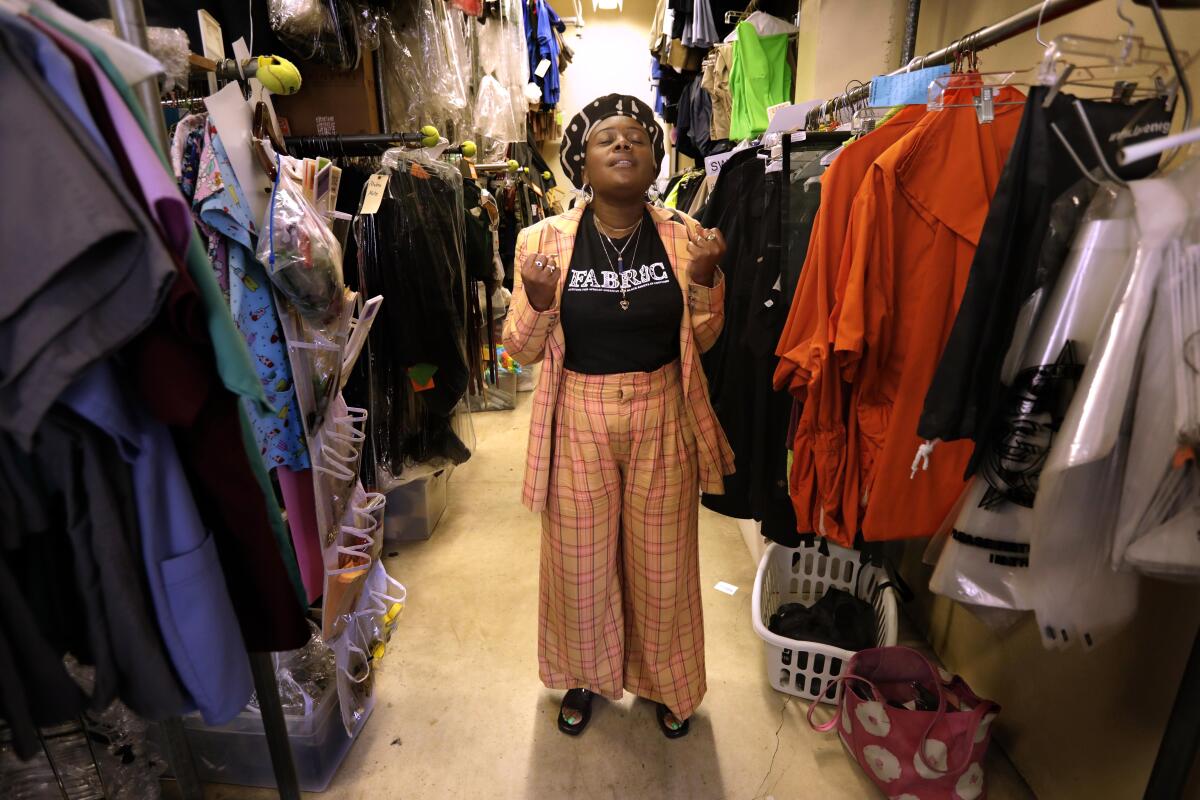The Super Bowl crypto ads were pretty weird

- Share via
I’m Ryan Faughnder, and this is the the Wide Shot, a newsletter about the business of entertainment. If this was forwarded to you, sign up here to get it in your inbox.
Depending on whom you ask, crypto is about to be the next game-changer for entertainment, or it’s an overhyped petri dish for scammers and people looking for a cash grab.
There are many reasons for Hollywood celebrities and movie studios to be genuinely interested in the growing crypto economy, with its NFTs and its metaverses, etc. Selling nonfungible tokens to crowd-fund film projects that would otherwise struggle to get made? Sure. Hosting fully virtual music festivals for digital token holders? Why not.
Entertainment companies have fallen behind the tech curve before (hello, Napster) and are not eager to repeat that history with Web3 — which is tech jargon for a next-generation internet, one based on blockchains, which are digital ledgers... you know what, other people can explain it.
None of this changes the fact that seeing celebrities hawking crypto on TV and on Twitter is weird, bordering on cringey, with Matt Damon in Crypto.com ads, Paris Hilton showing off her Bored Ape Yacht Club avatar and Reese Witherspoon’s “parallel digital identity” tweets.

The phenomenon had its Dot Com Bubble 2.0 moment during Super Bowl LVI, informally dubbed the “Crypto Bowl.” We covered this in a piece published Sunday night titled, “Et tu, Larry? Why so many celebrities are shilling for crypto.” A sample:
Larry David appeared as a clueless time traveler who turns up his nose at great innovations (The wheel? Eh. The lightbulb? “Can I be honest? ... it stinks.”) before pooh-poohing a pitch for crypto company FTX. The tagline: “Don’t be like Larry. Don’t miss out on the next big thing.” Later, LeBron James schooled his younger self about taking chances in an ad for Crypto.com.
It was widely anticipated that big names would back crypto and nonfungible tokens, or NFTs, during the big game. So much so that ahead of the match, cryptocurrency trading platform Binance dropped videos featuring the Miami Heat’s Jimmy Butler and music artist J. Balvin warning viewers against celebrity crypto endorsements.
The James ad was made by the basketball star and his business partner Maverick Carter’s SpringHill Co. and directed by Calmatic, the Los Angeles-based helmer of the firm’s upcoming “House Party” reboot. Synergy! James also posted a behind-the-scenes video in which a Crypto.com exec talks about “inspiring a new generation of builders to create a better version of the internet.”
The commercial features James talking to his younger self on the cusp of a massive life decision in 2003. “You want to make history? You got to call your own shots,” James the Elder tells James the Younger. Then, the Crypto.com slogan hits the screen: “Fortune favors the brave.” #FFTB.
There are a couple ways to sell crypto to a general audience that watches the Super Bowl, beyond normalizing a difficult-to-understand industry.
One is by inducing FOMO (fear of missing out). It’s a simple message, especially considering that actually explaining Crypto.com and FTX in a 30-second spot is basically impossible.
It’s also a perfect encapsulation of the you-only-live-once (YOLO) economy embraced by early movers in the NFT market. Remember how James bravely went into the NBA right after high school? Investing in Dogecoin is kind of like that. Buy in now, you wimps!
The other way is with free money.
There’s a strong case that the most effective crypto Super Bowl ad didn’t involve A-listers at all. Coinbase released a spot featuring a color-changing QR code bouncing across the screen, which sent viewers to a site offering $15 in coins for those who sign up by Feb. 15. It caused such a traffic spike that it crashed the company’s app.
There were some funny Twitter reactions to all this, including this one from comedian and writer Emily Heller: “All these celebrity crypto ads are destined for a supercut montage in the inevitable documentary after the recession.” Mike Drucker quipped, “You either die a hero or you live long enough to see yourself doing crypto ads.” (Disclosure: The Los Angeles Times is selling its own NFTs now.)
There were also the inevitable comparisons to the dot-com era, although skeptics disagree whether the crypto craze is more like the early 2000s tech bust or the late 2000s housing market collapse. A more-than-two-hour-long video by YouTuber Dan Olson making the latter case, in which he describes the NFT market as the “financialization of everything,” has more than 5 million views.
That sounds like a lot of views until you consider the tens of millions of people who watched the Los Angeles Rams defeat the Cincinnati Bengals at Inglewood’s SoFi Stadium — and probably saw those crypto commercials.
News and stuff

— A Hollywood union tried to promote diversity. Then things got complicated. Anousha Sakoui’s must-read Column One: Motion picture costumers launched a diversity committee to help support members of color. But committee members ended up resigning in frustration.
— Paradigm Talent Agency is leaving its Beverly Hills headquarters. From Rogert Vincent and Wendy Lee‘s scoop: The search for a new tenant marks a retreat for Paradigm, which moved into the space in 2018 after signing a long-term lease and spending millions on renovations.
— End of an era. Entertainment Weekly, InStyle and four other Meredith magazines will cease print publications.
— This deal’s a ‘go.’ Discovery and WarnerMedia win Justice Department clearance for merger. Next up, Amazon and MGM?
— Bob Weir’s long, strange dreams of Jerry Garcia and giant sheepdogs. A terrific interview with a rock hero by Joe Hagan.
Number of the week

Let’s talk about Disney+’s big subscriber gains. The Walt Disney Co. said its flagship streaming service grew by 11.8 million subscribers in the first fiscal quarter, easily beating Wall Street expectations and bringing its total to nearly 130 million.
Not a bad showing for Chief Executive Bob Chapek, considering investors were getting jitters last month about the state of the streaming business after Netflix’s earnings report.
It’s worth drilling into the numbers a bit more, though. Analysts and investors watch subscriber counts closely, as seen when Netflix’s stock cratered after the company projected slow growth in the current quarter. But not all subscribers are equal when it comes to revenue and what it costs to reel them in.
For example, Disney+ added 2 million subscribers, or about half of its domestic gains, because Disney decided to tack on the service (and ESPN+) for existing Hulu+Live TV subscribers as it raised the bundle price by $5 a month.
An additional 2.6 million subscribers came in via the very cheap Disney+Hotstar service in India and Indonesia. Because it generates average revenue per user (ARPU) of only about $1 a month, that service isn’t very meaningful to Disney’s bottom line. So, looking at it in the way some analysts do, Disney really added 7.1 million Disney+ subscribers.
That’s not to say that Disney+ is doing badly, but it does add some nuance to the story. It also serves as another example of how Disney has used low pricing and giveaways to become one of the industry’s top challengers to Netflix.
The strategy is working. But it means Disney makes less money from each subscriber than its rivals do. Including the Hotstar subs, the revenue per user for Disney+ is $4.41, the company reported. Netflix’s average revenue per membership is nearing $15 a month.
Given the low revenue per user and the amount of spending it takes to expand the app, Disney doesn’t expect to turn a profit on its streaming businesses until 2024.
Disney’s direct-to-consumer group — which includes Disney+, Hulu and ESPN+ — lost nearly $600 million in the first quarter alone, representing a 27% bigger loss than the same quarter a year ago. As we’ve noted, competing in streaming is still really, really expensive. The company plans to spend $33 billion overall on content this year, up $8 billion from last year.
Good thing its parks are healthy again. Disney’s parks, products and experiences segment made $2.45 billion in operating profit, blowing past expectations as visitors returned in droves and made healthy use of the Genie app function that charges parkgoers a fee for line-skipping at rides. The numbers bring the parks group back to pre-pandemic profit levels.
Gains for (some) female directors

A new study by USC’s Annenberg Inclusion Initiative suggests that women overall have benefited from pushes for increased diversity in Hollywood. But the same cannot necessarily be said for women of color.
Sakoui reports the numbers: “Overall, women directed about 13% of the top 100 movies last year, down slightly from the record level of 15% in 2020 but still up substantially from just 2.7% in 2007....
“Directors from marginalized groups also saw greater representation, reaching an all-time high of 27.3% in 2021, up from 12.5% in 2007. But the percentage of women of color did not change during the 15-year period surveyed by USC. They accounted for less than 2% of all top-grossing directors since 2007.”
This study comes during an Oscar race in which Jane Campion became the first woman to be nominated for best director more than once. The fact that this is a first tells you everything you need to know.
You should be reading...
— The little streaming service that couldn’t. Remember Seeso? The collapse of the NBCUniversal comedy streaming service gets the oral history treatment from Vulture.
— Bob Odenkirk’s long road to serious success. From the New York Times Magazine profile: “He was a comedian’s comedian — until ‘Better Call Saul’ revealed him as a peerless portrayer of broken souls. What will he turn himself into next?”
— Current and former “Dr. Phil” employees say the set is a toxic workplace. The show says everything’s fine. “This show destroyed me mentally, emotionally, and physically,” one former employee tells Buzzfeed.
Finally...
I haven’t seen “Jackass Forever” yet, though apparently plenty of people have. The Paramount movie has done pretty well at the box office, grossing $37.4 million so far. The release inspired me to watch the main three previous movies in the Johnny Knoxville series (no “Jackass 2.5” or 3.5 for me yet, sorry). They’re all streaming on Paramount+. My favorite bit is probably the jet engine stunt from “Jackass 3D.”
Also, some of the reactions to the Super Bowl halftime show (upside down 50 Cent!) were funny.
Inside the business of entertainment
The Wide Shot brings you news, analysis and insights on everything from streaming wars to production — and what it all means for the future.
You may occasionally receive promotional content from the Los Angeles Times.




